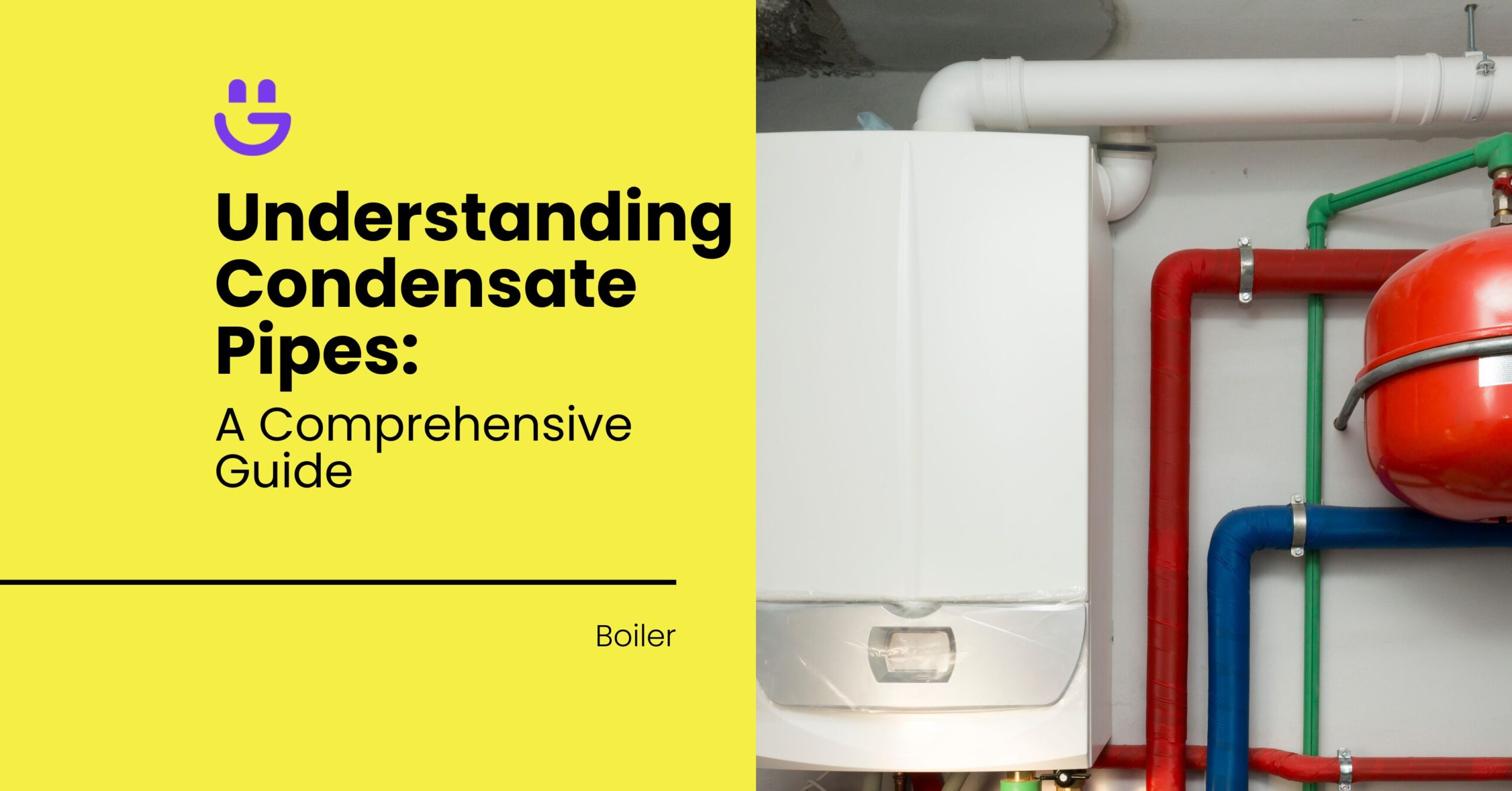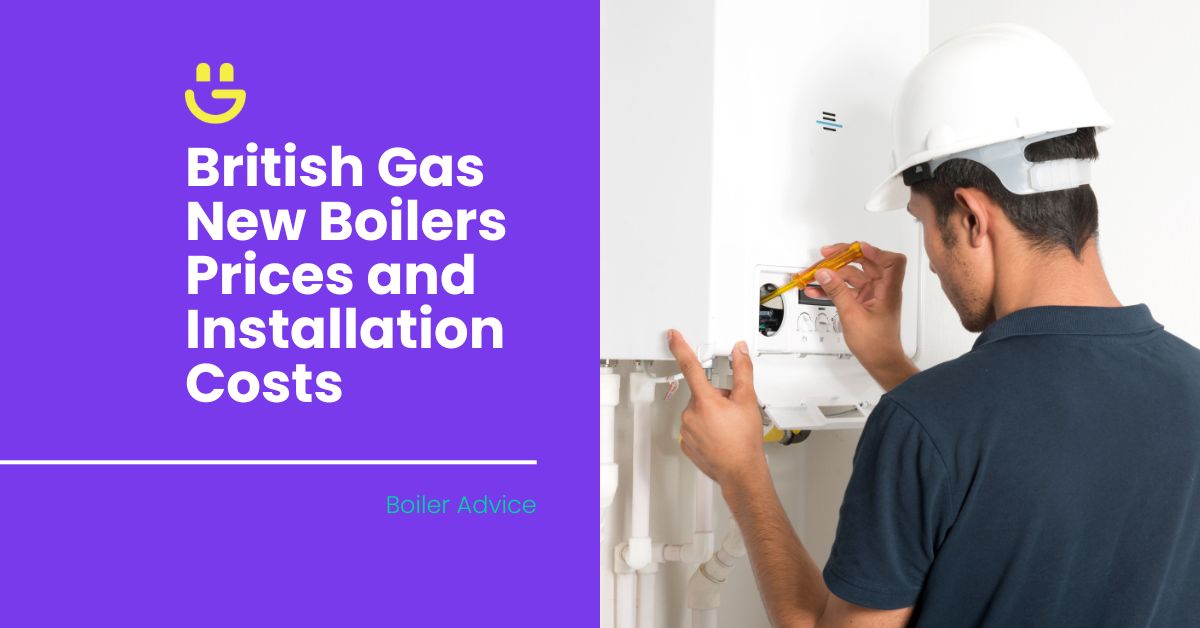Last Updated on November 14, 2025
Condensate pipes are the waste pipes in our heating systems, ridding our boilers of icky wastewater.
Most modern boilers are condensing boilers. While these fancy devices use gas to condense water vapour and generate heat, acidic wastewater is produced as a byproduct.
This is where the waste pipe comes in, of course!
In this article, we’ll guide you through everything you need to know about boiler condensate pipes: what they do, why they do it, and how they do it. – Lets dive in!
Contents
Condensate Pipes: Function And Importance
Before we go any further, let’s explain the meaning of “condensate.”
Condensate refers to the wastewater byproduct boilers produce when generating heat and hot water after pumping it through the system.
Function
When our boilers burn fuel, carbon dioxide and water vapour (steam) are released. When enough heat is produced, the vapour is condensed back into water. This water then drains through the boiler condensate pipe and eventually lands up in the sewer.
Importance
Modern boilers are more energy efficient than boilers of yesteryear – 90% more efficient, to be exact! In comparison, non-condensing boilers waste up to 50% of heat through the flue as they only generate heat from burning gases.
A condensing boiler is a high-efficiency boiler system that recycles water and reduces our carbon footprint. Condensate pipes are vital for boilers to function properly.
The science behind condensate
Changing heat into carbon dioxide (CO2) and steam is what these pipes do best. Let’s take a closer look at this:
- When cold water enters our central heating system, the boiler’s heat exchanger uses gas to convert this cold water into heating and hot water.
- CO2 and steam are released as a byproduct of this process.
- Once the boiler system cools down, these byproducts are converted back into water and emptied through the external condensate pipe into the drain.
This pipe collects about two litres of condensate every hour, adding to its 90% energy efficiency rate mentioned earlier.
Types of boilers and condensing mechanisms
Popular condensing boilers include:
- Alpha E-tec
- Ideal Logic
- Worcester Bosch 4000
- Viessmann Vitodens 100-w
Condensing boilers burn fuel to transfer as much heat as possible. The collected water droplets are eventually expelled as condensate water waste through the condensate pipe.
Overflow pipes need to be made from non-metallic materials, as steel and copper pipes can corrode from the acidity. Internal piping must measure at least 21.5 mm in width, whereas external pipes must be 32 mm with Type-O insulation.
Boiler condensate pipe regulations
- Since mid-2005, only condensing boilers are allowed to be installed in UK homes. These building regulations were put into place to help reduce the UK’s carbon footprint.
- In January 2021, the Heating and Hotwater Industry Council (HHIC) stated that due to the UK’s changing weather patterns, all condensate pipework must be installed internally. This is particularly helpful if you don’t want a frozen condensate pipe on your hands!
- If you have a combi boiler at home that was installed after 2005, it is likely to align with the above regulations.
Proper Installation And Positioning
When technicians are installing or repairing your condensing boiler, they will need to reroute the condensate pipe inside your house, as per the 2021 HHIC regulations (similar to toilet plumbing pipework or a sink waste pipe). When internal connections are not feasible, external pipes are allowed.
An external pipe must comply with these measures:
- It must be at least 30 mm wide.
- It needs to be insulated with UV-resistant and waterproof materials.
- An external pipe should be cut at a 45-degree angle (to prevent condensate pipe freezing).
- External condensate pipe insulation should be sealed to the external wall to prevent freezing.
- The discharge pipe must “fall” at least 45 mm per metre away from the boiler and take the shortest possible route to the drainage point.
- When connecting to the drain point, a longer external pipe is advised as opposed to a shorter one.
In cases where internal drainage points are inaccessible, the HHIC suggests that condensate pumps are used. A condensate pump connects to the pipe, which then connects to the internal soil stack.
Note: The soil stack is a vertical pipe that moves all wastewater from the soil pipes to the sewer in a single flow. These are usually installed internally in modern homes.
Alternatives for wastewater disposal
If you don’t want your household wastewater to drain into municipal sewers or have no external drainage points on your premises, opt for soakaways instead.
These “buried” drainage units filter waste at ground level as opposed to going through sewage systems. They connect to the waste pipe and wastewater is filtered through limescale chippings, neutralising the acidity.
Preventive Measures For Smooth Operations
If you can remember the UK winters of 2010 and 2018, sub-zero temperatures should come to mind first. It’s probably during this time that you may have experienced a frozen condensate pipe. To prevent this, consider installing auxiliary syphons or adding external trace heating units to your condensate pipe.
- Auxiliary syphon units are storage units that connect to the condensate pipe of your condensing boiler. They can hold an increased volume of condensate water, preventing it from freezing.
- Think of a trace heating unit as a hot water bottle, as it acts as an external thermostat for your condensate pipe. The pipe is wrapped in thermal insulation and the heat generated from the system keeps the pipes warm, preventing frostbite.
- Regular maintenance of your boiler system should also be done once a year to ensure your boiler unit (and boiler condensate pipe) remain in tip-top condition.
Frozen condensate pipes: causes and solutions
If your system stops working in the colder winter months, it’s possible that your condensate pipe is frozen. When your condensate wastewater pipe freezes, you’ll usually hear a gurgling noise coming from the boiler unit. An EA error code will also flash across the display screen on most boilers.
Luckily, you can mend this yourself without the need for a heating engineer. All you need to do is follow these steps:
- Locate the condensate pipe. This is usually a plastic pipe found behind the boiler unit that connects to the drainage point.
- Pour warm – NOT boiling or hot – water along the PVC pipes.
- When the condensate pipe has defrosted, reset your boiler unit and Bob’s your uncle!
FAQs
Where is the condensate pipe located?
A boiler condensate pipe is usually a white flexible pipe located at the back of your boiler. It runs down the external wall into the drain.
What comes out of a condensate pipe?
Acidic wastewater, formed as byproducts during the condensate process, is what comes out of your boiler’s condensate pipe.
Do all boilers need a condensate pipe?
Yes, all condensing boilers need a condensate pipe and won’t work without one. A system installed after 2005 has these pipes installed to align with boiler condensate pipe regulations.
Is the condensate pipe used to drain the boiler?
No, the condensate pipe is not the same outlet that is used to drain a boiler. Knowing how to drain a combi boiler – or any other boiler – is a useful skill to have if your boiler is starting to make noises or you find yourself without hot water. Usually, a boiler drain is the outlet used to drain a boiler to allow for maintenance.
Conclusion
It’s clear that a condensate pipe is more than just a component of your heating system; they’re essential for the high efficiency and eco-friendliness of modern boilers!
By understanding their function, installation and maintenance needs, you can be assured that your boiler condensate pipe operates at peak efficiency while reducing your carbon footprint.
Now that we’ve answered your question of “What is a condensate pipe?” you are now pro in the condensing process, from how it works to how to unfreeze your condensate pipe! But, if you have any more questions, make sure to contact the Eco Happy team today for assistance.






Tom Allen
Solar Expert